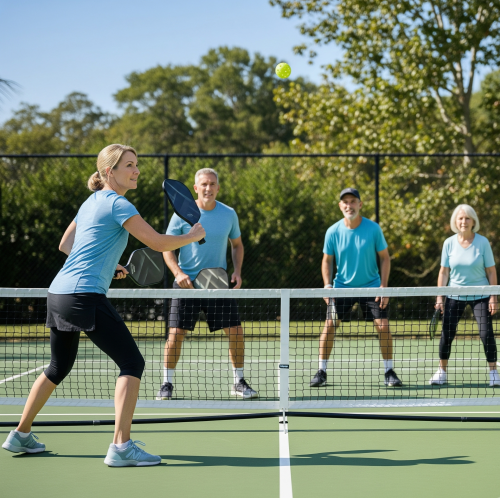The Rules of Pickleball Explained Simply: A Beginner's Guide

Pickleball rules are a mix of tennis and ping pong with unique twists. The game is played as singles or doubles on a badminton-sized court using paddles and a plastic ball. The goal? Score 11 points (win by 2), by legally serving and outplaying your opponent.
A key rule is that only the serving side can score a point. You start the serve underhand from the right-hand side of the court, diagonally across. After the serve, the receiving team must let the ball bounce once, and so must the serving team – this is the “two-bounce rule.” After that, you can volley or play off the bounce.
Then there’s the Non-Volley Zone – aka “the kitchen.” You can’t hit a volley (a ball without letting it bounce) while standing inside this zone. This keeps the game fair and reduces aggressive net play. Each game begins with one player serving once; after that, both teammates serve before the other team gets the chance.
Essential Pickleball Rules – Quick & Clear
- Scoring: Only the serving side can score. Games go to 11 (win by 2).
- Serving: Serve underhand from behind the baseline, diagonally. Keep the ball below your waist.
- Two-Bounce Rule: The ball must bounce once on each side before you can volley.
- Kitchen Rule: No volleys while standing in the Non-Volley Zone. Step out before hitting.
- Double Serve Rotation: In doubles, both players get a chance to serve (except on the very first serve of the game).
- Player Positioning: Server starts on the right side at even scores and left at odd scores.
- Let Serves: If the serve hits the net but lands in the correct service box, the rally continues – there are no “lets” anymore.
- Switch Sides: Players switch sides of the court with their partner after scoring a point on their serve.
- Faults: Serving out, hitting into the net, volleying in the kitchen, or ball bouncing twice ends the rally.
- Call Out the Score: Always say the score (server’s score first) before serving!
Pickleball’s rules might seem quirky at first – but once you understand the basics, the game becomes intuitive, fast, and incredibly fun. With just a paddle, a ball, and the confidence to start, you’re well on your way to joining a thriving community of players across the world.
At Runplaygo, we’re not just here to sell paddles – we’re here to fuel your entire journey. From beginner guides like this to expert tips and curated products, we help every player unlock their full potential on the court.
Now that you know the rules, what’s stopping you? Grab your gear and head to your nearest court. The fun (and friendly competition) is just getting started!
Term | Meaning | Why It Matters |
|---|---|---|
Kitchen (NVZ) | 7-foot no-volley zone on each side of net | Prevents aggressive net smashes |
Two-Bounce Rule | Ball must bounce once on each side post-serve | Encourages fair play and strategy |
Side-Out | Loss of service to the opponent | Keeps rally rotation organized |
Fault | Violation of rules that ends the rally | Helps define clean gameplay |
Serve Rotation | Changing serving player after side-out | Ensures fairness in doubles play |

